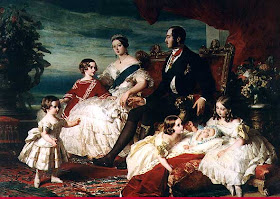 |
| Looking down on the Catacombs at Warstone Lane Cemetery in Birmingham. |
For three decades or more I have lived
a 20-minute train from Birmingham (England, not Alabama) and I had NO
IDEA the city has its own Catacombs until Younger Daughter took me
there a couple of weeks ago (before my mother was ill). Sadly, they
are all bricked up, so you can't go inside, and they look very
neglected, but nevertheless they are absolutely spectacular, ever so
slightly spooky, and well worth a visit.
They are slap-bang in the middle of the
Warstone Lane Cemetery, on the edge of the Jewellery Quarter, and
I've never seen anything like them. They reminded me of some kind of
Roman amphitheatre – something to do with the circular (or perhaps
that should be semi-circular) shape I think, and the terraces and the
arched entrances around a flat arena-like area. To start with we
assumed these were family vaults, but I've done a bit of research,
and as far as I can gather they were for poor folk, and coffins were
just stacked inside the tunnels, which sounds a bit grisly.
 |
| A closer view of the bricked-up tunnels. |
In the 19th century
Birmingham was a manufacturing power house where wealthy financiers
and businessmen made their fortunes. But the people who worked in the
factories lived in squalid conditions, with overcrowding, no proper
sanitation, and inadequate water supplies. Illness was rife and
mortality rates were high. Graveyards, apparently, were as
overcrowded as the streets of terraces and back-to-backs – so much
so that in some places 'boring rods' were used to check if there was
room for another burial! And at some of the city's churches there
were so many interments that the ground was raised several feet
above street level.
Facilities were obviously inadequate,
so a group of non-conformists established their own cemetery at Key
Hill in 1836, and 12 years later Birmingham
Church of England Cemetery Company established another
graveyard close by, at Warstone Lane. It was created in an old
sandpit, and the Catacombs were tunnelled into the sides on two
levels, to create more space, while normal burials in proper graves
took place on the rest of site.
 |
| Memorial stones have been inserted at the entrance to one or two tunnels. |
Bizarrely, when Christ Church, in the
centre of Birmingham, was demolished in 1899 the remains of 600
bodies were moved to the Warstone Lane Catacombs. They were taken in
funeral coaches, which travelled in a dignified, slow procession, as
was right and proper – but it was all a bit 'cloak and dagger'
because the journeys took place at night (under cover of darkness) so
residents wouldn't be disturbed, and it all sounds quite macabre.
Among those who were transferred to the
Catacombs was the renowned printer and typographer John Baskerville,
and the story of how he came to be there is very odd indeed. As an
atheist he had no wish to be buried in consecrated ground, so when he
died in 1775 he was buried in a mausoleum in his garden. , where he
lay forgotten some 50 years, until gravel was excavated from the
land. He was moved to a warehouse – where visitors paid sixpence
(which was probably a lot of money at the time) to see his embalmed
body! Then he was moved again, to the shop of a plumber and glazier.
By this time, of course, the body was less well preserved than it had
been, and people were no longer keen to see (or smell) it! In
desperation, the poor old plumber/glazier had the body buried
secretly at Christ Church, and from there poor old Baskerville's
mortal remains were shifted once again, to the tunnels at Warstone
Lane.
 |
| The view from the ground. |
Baskerville (one of the fonts he created) is still a classic typeface and, since I was once a journalist, I would have liked to pay a tribute to this great typographer and printer by using it for this post but it's not listed on Blogger or Open Office.
The cemetery also also provides the final resting place for Major Harry Gem who, with the help of a friend, invented lawn tennis in 1860 or thereabouts, and Pte James Cooper, who was awarded the Victoria Cross in 1867 for bravery at sea rescuing colleagues from cannibals in the Andaman Islands.
 |
| Part of the main graveyard at Warstone Lane. |
I'm not sure when the last burial in
the Catacombs took place, but apparently people lived in the tunnels
during WW2. However, I'm not sure if they were used as shelters
(like the London Tube stations), or whether bombed-out families set
up home in them. Either way, it must have been pretty unpleasant.
Today the entrances are bricked in and plastered over (to prevent
vandalism and accidents I suppose) although a couple do have memorial
stones set into them. A section of the wall is in danger of collapse
and has been shored up, and the whole area looks in need of some
tender loving care.
The entire cemetery, along with the one
at Keys Hill (which also has Catacombs, but I haven't been there
yet), is 'listed', and volunteers help maintain both areas, which are
not only architecturally unique, but have also become havens for
wildlife and plants. I think plans for improvements are included in an
ongoing scheme which takes in the whole of the Jewellery Quarter, so
hopefully something will done.
 |
| The blue brick Victorian lodge at Warstone Lane Cemetery still stands, although it has been sold for offices. But the Gothic chapel, dedicated to St Michael, was demolished in 1958. |
Edited, Saturday: I forgot to attribute my sources! Information in this blog was taken mainly from the website for the Jewellery Quarter at http://www.jquarter.org.uk/webdisk/walk14.htm and the book 'A History of Birmingham', by local historian Chris Upton.


.JPG)




























